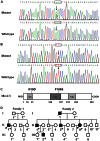Prevalence and spectrum of Nkx2.5 mutations associated with idiopathic atrial fibrillation
- PMID: 23778487
- PMCID: PMC3674279
- DOI: 10.6061/clinics/2013(06)09
Prevalence and spectrum of Nkx2.5 mutations associated with idiopathic atrial fibrillation
Abstract
Objective: The aim of this study was to evaluate the prevalence and spectrum of Nkx2.5 mutations associated with idiopathic atrial fibrillation (AF).
Methods: A cohort of 136 unrelated patients with idiopathic atrial fibrillation and 200 unrelated, ethnically matched healthy controls were enrolled. The coding exons and splice junctions of the Nkx2.5 gene were sequenced in 136 atrial fibrillation patients, and the available relatives of mutation carriers and 200 controls were subsequently genotyped for the identified mutations. The functional characteristics of the mutated Nkx2.5 gene were analyzed using a dual-luciferase reporter assay system.
Results: Two novel heterozygous Nkx2.5 mutations (p.N19D and p.F186S) were identified in 2 of the 136 unrelated atrial fibrillation cases, with a mutational prevalence of approximately 1.47%. These missense mutations co-segregated with atrial fibrillation in the families and were absent in the 400 control chromosomes. Notably, 2 mutation carriers also had congenital atrial septal defects and atrioventricular block. Multiple alignments of the Nkx2.5 protein sequences across various species revealed that the altered amino acids were completely conserved evolutionarily. Functional analysis demonstrated that the mutant Nkx2.5 proteins were associated with significantly reduced transcriptional activity compared to their wild-type counterpart.
Conclusion: These findings associate the Nkx2.5 loss-of-function mutation with atrial fibrillation and atrioventricular block and provide novel insights into the molecular mechanism involved in the pathogenesis of atrial fibrillation. These results also have potential implications for early prophylaxis and allele-specific therapy of this common arrhythmia.
Conflict of interest statement
No potential conflict of interest was reported.
Figures



Similar articles
-
A novel NKX2.5 loss-of-function mutation responsible for familial atrial fibrillation.Int J Mol Med. 2013 May;31(5):1119-26. doi: 10.3892/ijmm.2013.1316. Epub 2013 Mar 22. Int J Mol Med. 2013. PMID: 23525379
-
Mutational spectrum of the NKX2-5 gene in patients with lone atrial fibrillation.Int J Med Sci. 2014 Apr 7;11(6):554-63. doi: 10.7150/ijms.8407. eCollection 2014. Int J Med Sci. 2014. PMID: 24782644 Free PMC article.
-
PITX2C loss-of-function mutations responsible for idiopathic atrial fibrillation.Clinics (Sao Paulo). 2014 Jan;69(1):15-22. doi: 10.6061/clinics/2014(01)03. Clinics (Sao Paulo). 2014. PMID: 24473555 Free PMC article.
-
Familial Atrial Septal Defect and Sudden Cardiac Death: Identification of a Novel NKX2-5 Mutation and a Review of the Literature.Congenit Heart Dis. 2016 May;11(3):283-90. doi: 10.1111/chd.12317. Epub 2015 Dec 18. Congenit Heart Dis. 2016. PMID: 26679770 Free PMC article. Review.
-
NKX2-5: an update on this hypermutable homeodomain protein and its role in human congenital heart disease (CHD).Hum Mutat. 2010 Nov;31(11):1185-94. doi: 10.1002/humu.21345. Epub 2010 Oct 12. Hum Mutat. 2010. PMID: 20725931 Review.
Cited by
-
Genetic and non-genetic risk factors associated with atrial fibrillation.Life Sci. 2022 Jun 15;299:120529. doi: 10.1016/j.lfs.2022.120529. Epub 2022 Apr 3. Life Sci. 2022. PMID: 35385795 Free PMC article. Review.
-
Discovery of TBX20 as a Novel Gene Underlying Atrial Fibrillation.Biology (Basel). 2023 Aug 30;12(9):1186. doi: 10.3390/biology12091186. Biology (Basel). 2023. PMID: 37759586 Free PMC article.
-
Prevalence and Spectrum of TBX5 Mutation in Patients with Lone Atrial Fibrillation.Int J Med Sci. 2016 Jan 23;13(1):60-7. doi: 10.7150/ijms.13264. eCollection 2016. Int J Med Sci. 2016. PMID: 26917986 Free PMC article.
-
Genomics of Atrial Fibrillation.Curr Cardiol Rep. 2016 Jun;18(6):55. doi: 10.1007/s11886-016-0735-8. Curr Cardiol Rep. 2016. PMID: 27139902 Free PMC article. Review.
-
Novel and highly lethal NKX2.5 missense mutation in a family with sudden death and ventricular arrhythmia.Pediatr Cardiol. 2014 Oct;35(7):1206-12. doi: 10.1007/s00246-014-0917-3. Epub 2014 Jun 1. Pediatr Cardiol. 2014. PMID: 24880466
References
-
- Fuster V, Rydén LE, Cannom DS, Crijns HJ, Curtis AB, Ellenbogen KA, et al. 2011 ACCF/AHA/HRS Focused Updates Incorporated Into the ACC/AHA/ESC 2006 Guidelines for the Management of Patients With Atrial Fibrillation: A Report of the American College of Cardiology Foundation/American Heart Association Task Force on Practice Guidelines. Circulation. 2011;123(10):e269–367. - PubMed
-
- Lloyd-Jones DM, Wang TJ, Leip EP, Larson MG, Levy D, Vasan RS, et al. Lifetime risk for development of atrial fibrillation: the Framingham Heart Study. Circulation. 2004;110(9):1042–6. - PubMed
-
- Miyasaka Y, Barnes ME, Gersh BJ, Cha SS, Bailey KR, Abhayaratna WP, et al. Secular trends in incidence of atrial fibrillation in Olmsted County, Minnesota, 1980 to 2000, and implications on the projections for future prevalence. Circulation. 2006;114(2):119–25. - PubMed
Publication types
MeSH terms
Substances
LinkOut - more resources
Full Text Sources
Other Literature Sources
Medical

